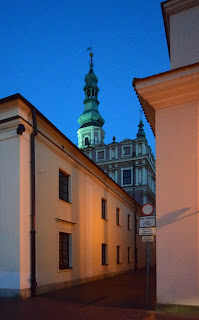The causal chain of events leading up to last Thursday's vote was as follows:
May 2004 - the UK labour market is opened to citizens of the eight new EU countries, of which Poland was the largest, on the very day of EU enlargement.
January 2013 - Premier David Cameron promises an in/out referendum on EU membership. By doing so, he paves the way for Conservative electoral victory in May 2015.
March 2013 - the UK government agrees to hold an in/out referendum on Scotland's independence. Mr Cameron ensured there was no third option, namely 'devo max', giving Scots the chance to vote for maximum devolution from London, but falling short of full independence.
September 2014 - Scots vote by 55% to 45% to remain in the United Kingdom.
May 2015 - David Cameron wins a second term as premier, buoyed by the result of the referendum that held the Union together, and by the promise of an EU referendum.
February 2016 - David Cameron announces the date of the referendum. He'd just returned from Brussels having negotiated reforms with the rest of the EU, reforms that the British media decried as being virtually meaningless.
June 2016 - Britain votes by 52% to 48% to leave the EU.
Let's look at how this came to pass.
Back in 2004, Tony Blair's government had the option of a seven-year transition period to shield the UK's labour market from the effects of unrestricted free movement of labour, which is one of the EU's four freedoms - movement, goods, services and capital. Germany, sensing that opening its labour market could mean a flood of Poles, Czechs, Slovaks and Hungarians coming there to work, chose to deploy the transitional arrangements. But with UK job vacancies running at around 600,000 and many employers calling out for workers - not cheap workers - but
any workers - the Blair government chose economic growth over social cohesion. In any case, the number of migrants that would come from the eight new accession countries to work in the UK had been estimated at 13,500 a year.
This estimate, upon which the government decided to open the door to migrant workers from the so-called Accession Eight (A8) countries, was wrong by a factor of twenty. It is, I would argue, the main cause of the last Thursday's result.
Hundreds of thousands came each year, and - unlike previous waves of migration to the UK which tended to remain in the cities, the new migrants fanned out across the country to find work in warehouses, hotels, slaughterhouses, farms, distribution centres and factories in small rural communities that had rarely seen a foreign face before.
Previous waves of migrants, in the 1950s, '60s, '70s, '80s and '90s were predominantly coloured. Strong anti-racist legislation made criticism of migration akin to incitement to racial hatred. But then the newest wave began to arrive in larger numbers in a shorter time than ever before in the history of migration to Britain. And this time, they were white. So suddenly it was OK to say "I don't like migration" because that statement no longer equated with "I don't like coloured people".
While the educated classes that had their gripes with the EU, the way it was run, its centralising and federalising tendencies, democratic accountability, loss of national sovereignty etc, the less well-off in smaller towns across the UK - the losers in the process of globalisation - saw the promised referendum as being about migration and "taking control of our borders".
The leaders of the Brexit campaign could see the bind that they were in. They knew full well that to ensure full 'control of the borders' could only be achieved by total disengagement from the EU and the European Economic Area. Which would mean re-negotiating trade agreements with the EU as a complete outsider, and having to accept tariffs on trade. Which would mean economic hardship for many years. Business needs to be part of the single European market if its economy is not to suffer. The Brexiteers were less than straight with the migrant-fearing electorate, suggesting that somehow EU migration could be controlled (read 'stopped') while market access would remain.
It was the publication on 27 May of the official net migration figures for 2015 that tipped the polls in favour of Brexit. Before that time, Remain tended to show a narrow lead. After the publication of the data, which showed 330,000 more people migrating to the UK than leaving it, support for Leave took the lead in the polls, and remained there until the killing of Jo Cox. That resulted in the polls showing a narrow 'Remain' lead. In the end migration worries trumped the wave of sympathy for the dead MP.
Many of England's larger cities did not want to leave the EU.
London voted 60% in favour of remaining.
Manchester voted 60% in favour of remaining.
Bristol voted 60% in favour of remaining.
Liverpool voted 58% in favour of remaining.
York voted 58% in favour of remaining.
Leicester voted 51% in favour of remaining.
Leeds voted 50% in favour of remaining.
[Just under 50% of Birmingham voted to remain.]
These cities have known mass migration for decades and have long adopted a tolerance for diversity. When I was in primary school in West London in the mid-1960s, one-third of my class were either immigrants or children of immigrants. So new waves of migrants coming to London or Manchester or Liverpool have not unduly worried the population in those cities.
Correlating Electoral Commission results with census data from 2001 and 2011, the areas of England that voted most heavily for Brexit were not those with the largest proportions of migrants, but those that had seen the fastest rise in immigration since EU enlargement.
Scotland voted 62% in favour of remaining in the EU (compared to 55% in favour of remaining in the UK in the September 2014 referendum). Northern Ireland voted 56% in favour of remaining in the EU. Scotland and Northern Ireland also experienced rapid rises in new-EU migration post-2004, but Scotland has a population density five times lower than England, while Northern Ireland has a different set of issues altogether.
Voting to leave the EU was predominantly small-town England. The most votes for 'leave' were from Boston, Lincolnshire (80%). According to the 2011 census, 11% of Boston's population was born in Poland, Lithuania or other new EU member states. The new influx came to work in agriculture and logistics; the jobs were evidently there, employers were welcoming them.
[And from Wikipedia, about Boston, this: "In the mid-2000s Boston was shown to have the highest obesity rate of any town in the United Kingdom, with one-third of its adults (31%) considered clinically obese. Obesity has been linked to social deprivation." I'll let you, dear readers, draw your own conclusion.]
Worried about the seemingly unstoppable rise in migration from Central and Eastern Europe, the less advantaged citizens of English and Welsh towns and villages voted to leave the EU.
Some - like Boston - have felt the impact of CEE migration to their towns, and from first hand experience, voted 'Leave' to try to stop it. Other small towns and villages have experienced little migration of any kind (such as Amber Valley in Derbyshire, where my brother lives), and yet voted strongly 'Leave'.
It would be interesting to tally the referendum results with data from the 2011 Census, to see whether large numbers of people born in the A8 countries resulted in a boost for 'Leave' - Ealing (60% 'Remain') also has a large Polish-born population, but then Ealing has had many immigrants living there for over half a century.
Economic arguments did not deter the English for voting 'Leave'. The case of Sunderland, home to the Nissan factory than employs 6,500 people, which voted 61% to leave, ignoring the fact that Nissan will not invest in new production lines in the factory should the UK leave the EU, is written up in the Financial Times today. The story shows how poorly thought through the decision was for many voters, who did not consider the consequences of their actions before polling day.
What happens next is a combination of so many known and unknown unknowns as to defy any serious attempt at prediction.
I recommend, in similar tone,
this piece by British-Polish novelist B.E. Andre
This time last year:
Still flying after all these years
This time two years ago
Yorkshire's smallest city
This time three years ago:
Cramp in the night
This time four years ago:
Football goes home
This time five years ago:
Birds of Omen
This time six years ago:
Yes, it does matter who you vote for
This time seven years ago:
Poland could do with some more mountains
This time eight years ago:
Warmth of the Sun - the Beach Boys and Noctilucence
This time nine years ago:
Polish roads that look like America




































